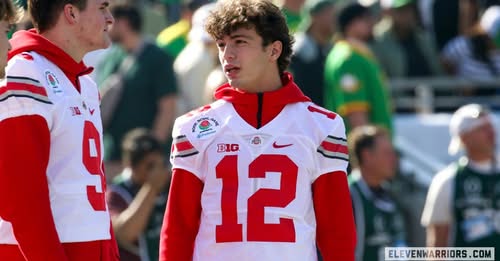Cody Haddad served as a three-year starter for St. Ignatius High School, one of Northeast Ohio’s premier football programs.
Cody Haddad’s football journey began in the heart of Northeast Ohio, a region deeply embedded with a rich tradition of high school football excellence. Growing up surrounded by the passion and pride that defines the sport in that part of the country, Haddad was drawn to the gridiron from an early age. That passion led him to St. Ignatius High School in Cleveland, a powerhouse program with a storied history of producing top-tier talent and developing young men into high-character athletes. It was at St. Ignatius that Haddad truly came into his own, not just as a football player, but as a leader and an anchor in one of the most respected programs in the state.
From the moment Haddad first stepped onto the field for St. Ignatius, it was clear he was destined to be more than just another player. He possessed a natural football instinct—an uncanny ability to read the game, anticipate plays, and position himself to make impactful contributions. Coaches quickly took notice of his discipline, work ethic, and football IQ. By the time he was a sophomore, Haddad had earned a starting role on the varsity team, no small feat in a program that routinely fields Division I-level talent across every position. Earning that spot wasn’t simply about athletic ability; it was a reflection of his tireless dedication in the film room, in the weight room, and on the practice field.
As a three-year starter, Haddad brought consistency and stability to the St. Ignatius secondary. His presence in the defensive backfield was a calming force, not just for his teammates, but for the coaching staff as well. Game after game, he delivered solid performances that included textbook tackling, timely pass breakups, and a knack for making crucial interceptions. His ability to stay composed under pressure helped elevate the team’s overall performance, particularly during high-stakes playoff matchups. Coaches often relied on him to mentor younger players and to serve as a vocal leader, both on and off the field.
Haddad’s junior year was particularly emblematic of his growth and rising status. By then, he was no longer just filling a role; he was setting the tone for the defense. In a season filled with tough opponents and tense matchups, Haddad’s leadership shone brightest during rivalry games and regional showdowns. His ability to lock down top receivers and force offenses to alter their game plan was a huge asset for the Wildcats. He became known for his anticipation and game awareness, frequently disrupting plays before they could develop. Coaches praised his ability to understand complex defensive schemes and to execute them with precision.
Off the field, Haddad’s influence was just as significant. He embraced the St. Ignatius philosophy of developing the whole person—intellectually, morally, and athletically. In the classroom, he was a focused and driven student. Among his peers, he earned a reputation for being grounded, respectful, and humble. Those qualities made him a natural fit for a leadership role, and he was often called upon to speak to underclassmen, lead team meetings, and set the tone for practices. His approach to football was businesslike but never joyless. He played with intensity but never lost sight of the values instilled in him by his coaches and community.
In his senior season, Haddad emerged not just as a key player but as the heart and soul of the team. That year, he took on even greater responsibility, calling coverages, helping younger players adjust mid-game, and ensuring everyone stayed focused and aligned. His football instincts had matured to the point where he could read an opposing quarterback’s eyes and break on the ball before the throw even left their hand. His highlight reel from that season included multiple game-saving plays, from critical fourth-down stops to momentum-shifting interceptions. But more than the statistics or accolades, it was his resilience, accountability, and leadership that stood out.
Recruiters began to take serious notice of Haddad during his final two years. While he may not have had the prototypical size or flash of some other prospects, he made up for it with sound fundamentals, a sharp mind, and a relentless motor. College scouts were impressed by his tape, but they were equally swayed by glowing recommendations from his coaches and the respect he commanded from teammates. He was described by more than one coach as a “program guy”—someone who would elevate the culture of any college football program he joined.
What set Haddad apart was his understanding of what it meant to be a student-athlete at a school like St. Ignatius. The Wildcats don’t simply prepare players for the next level athletically—they prepare them for life. That philosophy was evident in Haddad’s every move. Whether he was leading warmups, offering tips to a freshman during practice, or standing tall during the national anthem, he embodied the ideals of respect, discipline, and integrity. Those qualities didn’t just make him a better player—they made him a better teammate and person.
While many young athletes chase headlines or focus solely on personal accolades, Haddad remained team-oriented throughout his high school career. He celebrated others’ successes as much as his own. After games, he was quick to deflect praise and instead highlight the work of the defensive line, linebackers, or coaching staff. That humility didn’t go unnoticed. In a sport often fueled by ego and individual branding, Haddad’s team-first mindset resonated with those around him.
St. Ignatius is known for playing one of the most demanding schedules in Ohio, and that competitive environment helped sharpen Haddad’s skills week after week. Facing off against elite offenses required adaptability and mental toughness. Haddad thrived in those conditions, embracing every challenge as an opportunity to learn and grow. He didn’t shy away from contact or tough assignments; he welcomed them. Whether tasked with shutting down the opponent’s top wideout or rotating down into the box to support the run, Haddad approached every snap with intensity and preparation.
His contributions weren’t limited to defense, either. Haddad’s versatility allowed him to occasionally step in on special teams, where he provided valuable coverage and helped flip field position. That willingness to contribute in multiple phases of the game underscored his unselfishness and commitment to the team’s success. He was the kind of player who never took a play off, never backed down from a challenge, and never let his team down in the clutch.
Even after his final snap at St. Ignatius, Haddad left an enduring legacy. Younger players cited him as an example to follow. Coaches pointed to his game film and practice habits as a model of how to prepare. And for those who had the chance to play alongside him, the experience was one of both camaraderie and inspiration. He had set a standard, not only with his play but with his character.
As he transitioned to the next chapter of his football career, Haddad carried with him all the lessons learned during his time at St. Ignatius. The discipline, the preparation, the leadership, and the selflessness—these traits would continue to serve him well. He may have entered St. Ignatius as a promising young athlete with raw talent, but he left as a complete player and a respected leader.
Cody Haddad’s story isn’t one of overnight success or headline-grabbing performances. It’s a story of steady, determined growth—a story rooted in hard work, humility, and a genuine love for the game. As a three-year starter at one of the most demanding high school football programs in the Midwest, Haddad proved himself time and time again. He didn’t just wear the St. Ignatius jersey—he honored it. And in doing so, he cemented his place in the proud tradition of a school that knows what greatness looks like, both on and off the field.



